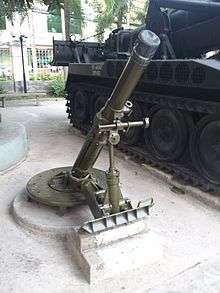M30 mortar
| US M30 | |
|---|---|
 | |
| Type | Mortar |
| Place of origin | United States |
| Service history | |
| In service | 1951 - Present |
| Used by | U.S. Army, Saudi Arabian Army, Hellenic Army, Brazilian Army, Philippine Army, Philippine Marine Corps |
| Specifications | |
| Weight | 305 kg (672.25 lb) |
| Length | 1.524 m (5 ft) |
|
| |
| Caliber | 106.7 mm (4.2 in) |
| Rate of fire | 18 rpm max., 3 rpm sustained |
| Effective firing range |
770 m to 6,840 m (840 yd to 7,480 yd) |
| Maximum firing range | 6,840 m (7,480 yd) |
The M30 106.7 mm (4.2 inch, or "Four-deuce") heavy mortar is an American rifled, muzzle-loading, high-angle-of-fire weapon used for long-range indirect fire support to infantry units.
Design

The M30 system weighs 305 kg including the complete mortar with a welded steel rotator, M24A1 base plate and M53 sight.
A point of interest in the design of this mortar is the rifled barrel. A rifled barrel requires the round to be a very tight fit to the bore in order for the rifling to engage the round and impart rotation to it. But in a muzzle-loading mortar, the round has to be loose enough in the bore to drop in from the front. In order to have it both ways, these rounds have an expandable ring at the base which expands into the rifling under the pressure of the explosion of the firing charge which propels the round. Additionally, imparting a spin to a round causes it to drift away from the direction of fire during flight and the longer the flight (greater range to target), the farther the drift, so the computation for setting the direction for firing at a specific target has to account for this drift.
American rounds are designed to be drop-safe and bore-safe. As such, the fuzes in the rounds for this rifled mortar did not arm unless the round was spun a certain number of times i.e. the round was not armed until it had exited the barrel spinning and traveled a safe distance from the gun emplacement.
Types of rounds
- HE M329A1—max range 5,650 m (6,180 yd), weight 12.3 kg (27 lb)
- HE M329A2—max range 6,840 m (7,480 yd), weight 10 kg (22 lb)
- WP M328A1—max range 5,650 m (6,180 yd)
- ILLUM M325A2—max range 5,490 m (6,004 yd), 90-second burn time
- ILLUM M335A2—max range 5,290 m (5,785 yd), 70-second burn time
WP is white phosphorus ("Willy-Pete")
ILLUM is illumination, a parachute flare round with fixed timed detonation. Deployment height above ground is determined by gun elevation angle and propelling charge.
HE and WP rounds could be fitted with various fuses before firing including a proximity fuse set for detonation at about 30 feet above ground to maximize the effected target area and to spray shrapnel down into foxholes.
There was also a sub-caliber training device that utilized blank 20 gauge shotgun shells to propel an inert training round a few hundred meters. This training was for gunnery skills of laying (in a sense, aiming) the guns.
History
The M30 entered service with the U.S. Army in 1951, replacing the previous M2 106.7 mm mortar.[1] It was adopted due to the extended range and lethality in comparison to the previous M2 4.2 inch (106.7 mm) mortar, although the M30, at 305 kilograms, was significantly heavier than the 151 kilogram M2.
Due to this heavy weight the mortar was most often mounted in a tracked mortar carrier of the M113 family, designated as the M106 Mortar Carrier. This vehicle mounted mortar was crewed by 5 people: the track commander (mortar sergeant/gun commander), gunner, assistant gunner, ammunition bearer and vehicle driver. Ground mounting of the mortar was time consuming and strenuous as a hole had to be dug for the base plate of the mortar to rest in, sandbags had to filled and placed around the base plate to stabilize it and to protect the exposed ammunition. Also this decreased the accuracy of the weapon as the recoil from firing caused the base plate to shift in the ground. This movement also made the crew have to "lay" the gun back on the aiming stakes more often, causing a temporary lack of fire while the weapon was repositioned and re-sighted back to its original reference point.
Notes
- ↑ 4.2 inch M30 Mortar. Rt66.com
See also
| Wikimedia Commons has media related to 4.2 inch Mortar M30. |
Chapter 6, FM 23-90: 4.2-Inch Mortar, M30
- List of artillery
- List of crew served weapons of the US Armed Forces
- Chemical mortar battalions of the United States Army